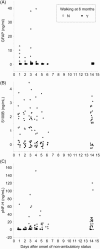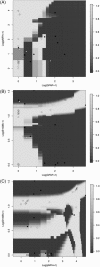Time course and prognostic value of serum GFAP, pNFH, and S100β concentrations in dogs with complete spinal cord injury because of intervertebral disc extrusion
- PMID: 30758078
- PMCID: PMC6430936
- DOI: 10.1111/jvim.15439
Time course and prognostic value of serum GFAP, pNFH, and S100β concentrations in dogs with complete spinal cord injury because of intervertebral disc extrusion
Abstract
Background: A noninvasive biomarker is needed to predict recovery from severe spinal cord injury (SCI) because of thoracolumbar intervertebral disc extrusion (TL-IVDE). Proteins released from neural and glial cells can be detected in the blood and show promise as prognostic tools, but their concentration is influenced by time after injury.
Hypothesis/objectives: Serum concentrations of glial fibrillary acidic protein (GFAP), phosphorylated neurofilament heavy chain (pNFH), and S100β will follow different time courses; measurement of combinations of these proteins will predict outcome.
Animals: Thirty-one dogs with TL-IVDE causing paralysis with no pain perception.
Methods: Prospective study. Serum samples were taken at presentation and intervals over 56 days and banked at -80°C. Glial fibrillary acidic protein, pNFH, and S100β concentrations were measured using ELISA tests and plotted against time from onset of nonambulatory status. Outcome was established at 6 months. The association between biomarker concentration and outcome was examined using logistic regression, receiver operator characteristics curve analysis, and model development.
Results: Thirty-one dogs participated, 3/31 (10%) developed progressive myelomalacia and 19/31 (62%) recovered ambulation. Glial fibrillary acidic protein and S100β concentrations rose for the first 1 to 3 days, and were undetectable by 14 and 28 days, respectively. Phosphorylated neurofilament heavy chain concentrations peaked at 14 days and were detectable at 56 days. Glial fibrillary acidic protein concentrations in the first 72 hours after onset of nonambulatory status predicted recovery with an accuracy of 76.7%-89% depending on sample timing.
Conclusions and clinical importance: Serum GFAP concentrations can be used to predict outcome in clinically complete SCI. A rapid inexpensive bedside test is needed.
Keywords: biomarker; intervertebral disc disease; myelomalacia; prognosis.
© 2019 The Authors. Journal of Veterinary Internal Medicine published by Wiley Periodicals, Inc. on behalf of the American College of Veterinary Internal Medicine.
Conflict of interest statement
Authors declare no conflict of interest.
Figures


Similar articles
-
Serum phosphorylated neurofilament heavy chain as a diagnostic biomarker for progressive myelomalacia in dogs with thoracolumbar intervertebral disc herniation.J Vet Intern Med. 2021 Sep;35(5):2366-2373. doi: 10.1111/jvim.16251. Epub 2021 Sep 2. J Vet Intern Med. 2021. PMID: 34476832 Free PMC article.
-
GFAP out-performs S100β in detecting traumatic intracranial lesions on computed tomography in trauma patients with mild traumatic brain injury and those with extracranial lesions.J Neurotrauma. 2014 Nov 15;31(22):1815-22. doi: 10.1089/neu.2013.3245. Epub 2014 Sep 12. J Neurotrauma. 2014. PMID: 24903744 Free PMC article.
-
The Effect of Electromagnetic Fields on Post-Operative Pain and Locomotor Recovery in Dogs with Acute, Severe Thoracolumbar Intervertebral Disc Extrusion: A Randomized Placebo-Controlled, Prospective Clinical Trial.J Neurotrauma. 2018 Aug 1;35(15):1726-1736. doi: 10.1089/neu.2017.5485. Epub 2018 Apr 2. J Neurotrauma. 2018. PMID: 29310504
-
ACVIM consensus statement on diagnosis and management of acute canine thoracolumbar intervertebral disc extrusion.J Vet Intern Med. 2022 Sep;36(5):1570-1596. doi: 10.1111/jvim.16480. Epub 2022 Jul 25. J Vet Intern Med. 2022. PMID: 35880267 Free PMC article.
-
Urological Sequelae to Acute Spinal Cord Injury in Pet Dogs: A Natural Disease Model of Neuropathic Bladder Dysfunction.Top Spinal Cord Inj Rehabil. 2019 Summer;25(3):205-213. doi: 10.1310/sci2503-205. Top Spinal Cord Inj Rehabil. 2019. PMID: 31548787 Free PMC article. Review.
Cited by
-
Ambulation in Dogs With Absent Pain Perception After Acute Thoracolumbar Spinal Cord Injury.Front Vet Sci. 2020 Aug 26;7:560. doi: 10.3389/fvets.2020.00560. eCollection 2020. Front Vet Sci. 2020. PMID: 33062648 Free PMC article. Review.
-
On the utility of cerebrospinal fluid biomarkers in canine neurological disorders.Sci Rep. 2024 Oct 15;14(1):24129. doi: 10.1038/s41598-024-73812-y. Sci Rep. 2024. PMID: 39406773 Free PMC article.
-
Serum phosphorylated neurofilament heavy chain as a diagnostic biomarker for progressive myelomalacia in dogs with thoracolumbar intervertebral disc herniation.J Vet Intern Med. 2021 Sep;35(5):2366-2373. doi: 10.1111/jvim.16251. Epub 2021 Sep 2. J Vet Intern Med. 2021. PMID: 34476832 Free PMC article.
-
Clinical presentation, diagnosis, treatment, and outcome in 8 dogs and 2 cats with global hypoxic-ischemic brain injury (2010-2022).J Vet Intern Med. 2023 Jul-Aug;37(4):1428-1437. doi: 10.1111/jvim.16790. Epub 2023 Jun 14. J Vet Intern Med. 2023. PMID: 37316975 Free PMC article.
-
A Controlled Clinical Study of Intensive Neurorehabilitation in Post-Surgical Dogs with Severe Acute Intervertebral Disc Extrusion.Animals (Basel). 2021 Oct 22;11(11):3034. doi: 10.3390/ani11113034. Animals (Basel). 2021. PMID: 34827767 Free PMC article.
References
-
- Aikawa T, Fujita H, Kanazono S, Shibata M, Yoshigae Y. Long‐term neurologic outcome of hemilaminectomy and disk fenestration for treatment of dogs with thoracolumbar intervertebral disk herniation: 831 cases (2000‐2007). J Am Vet Med Assoc. 2012;241:1617‐1626. - PubMed
-
- Olby N, Harris T, Burr J, Muñana K, Sharp N, Keene B. Recovery of pelvic limb function in dogs following acute intervertebral disc herniations. J Neurotrauma. 2004;21:49‐59. - PubMed
-
- Ferreira AJA, Correia JHD, Jaggy A. Thoracolumbar disc disease in 71 paraplegic dogs: influence of rate of onset and duration of clinical signs on treatment results. J Small Anim Pract. 2002;43:158‐163. - PubMed
-
- Jeffery ND, Levine JM, Olby NJ, Stein VM. Intervertebral disk degeneration in dogs: consequences, diagnosis, treatment, and future directions. J Vet Intern Med. 2013;27:1318‐1333. - PubMed
-
- Olby N, Levine J, Harris T, Muñana K, Skeen T, Sharp N. Long‐term functional outcome of dogs with severe injuries of the thoracolumbar spinal cord: 87 cases (1996‐2001). J Am Vet Med Assoc. 2003;222(6):762‐769. - PubMed
MeSH terms
Substances
Supplementary concepts
Grants and funding
LinkOut - more resources
Full Text Sources
Medical
Miscellaneous

